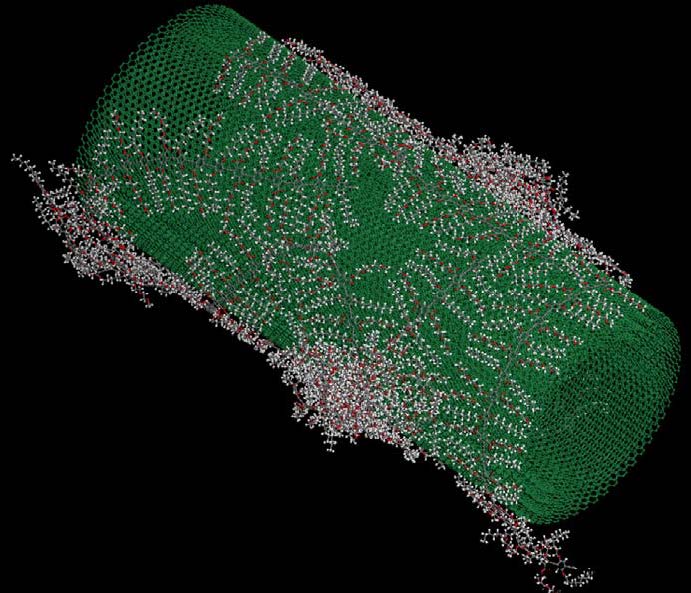left: With Ohio Supercomputer Center access, Sadhan Jana at the University of Akron simulated the equilibrium state of organization of 12 organic tie-molecules on the surface of MWCNT. The red dots represent oxygen, white represent hydrogen, and gray represent carbon atoms in tie molecules.
Carbon nanotubes (CNTs) attract great attention for their strong potential in applications involving aerospace/naval materials, nano-electrical products, optical devices, chemical sensors, catalyst supports, water/gas treatments, drug carriers and artificial tissues. These future applications are spurred by the extraordinary mechanical, optical, thermal and electrical properties and chemical sensitivity to small molecules of CNTs.
“The biggest obstacle in realizing the full potential of CNTs is agglomerate formation owing to van der Waals and electrostatics interactions between individual CNT particles,” explained Sadhan C. Jana, Ph.D., professor and chair of Polymer Engineering at the University of Akron. “Researchers have devised several methodologies to weaken such interactions. Of these, the chemical functionalization is an effective method when dispersion and stabilization CNTs are sought in polar liquids, including polymers.”
Two major approaches are followed for functionalization of CNTs — covalent and non-covalent. In a covalent approach, chemical bonds are formed with the surface carbon atoms, which often alters the graphitic characters of CNTs and compromises electrical conductivity and mechanical strengths. In contrast, a non-covalent approach utilizes adsorption of uniquely designed tie molecules, helping to improve the stability of CNTs without compromising the mechanical integrity.
Jana and Jie Feng, Ph.D., conducted computer simulations of tie molecule adsorption through the Ohio Supercomputer Center and obtained estimates of improvements of mechanical properties and thermal conductivity. They focused on gaining a fundamental understanding of physical adsorption mechanism of such tie molecules from solutions onto surfaces of multi-walled carbon nanotubes (MWCNTs). The tie molecules may include polymers, surfactants and biopolymers. The CNTs treated with the tie molecules may be used in the fabrication of sensors and devices or may be compounded with the host polymers to create bulk polymer composites.
“The methods we devised allow a large-scale quantitative investigation of MWCNT nanocomposites in solution,” Feng said. “The method can also be extended to the study of interfacial problems involving interactions between the polar and non-polar molecules with organic and inorganic fillers in solutions.”
Jana and Feng are collaborating with experimentalists at Zyvex Technologies and PolyOne Corporation to provide industry with guidance and theoretical explanations to aid in developing tie molecules and value-added composite materials for automotive, naval and aerospace industry applications.
--
Project lead: Sadhan C. Jana, University of Akron
Research title: Hybrid modeling of functionalization of carbon nanotubes
Funding source: Ohio Third Frontier
Web site: www.poly-eng.uakron.edu/jana.php
